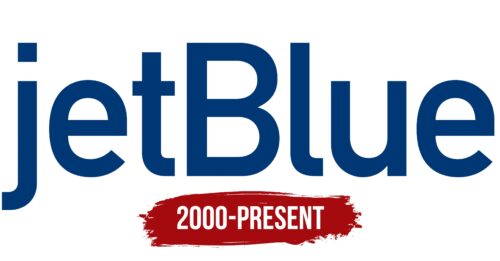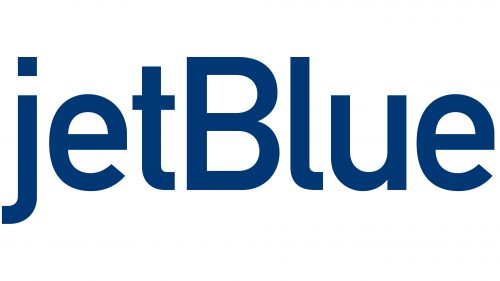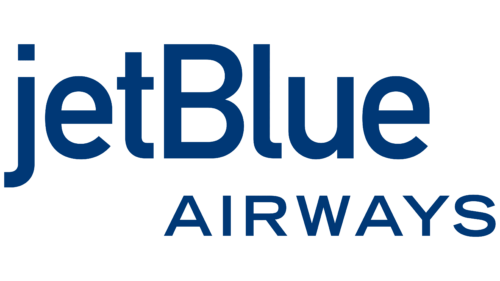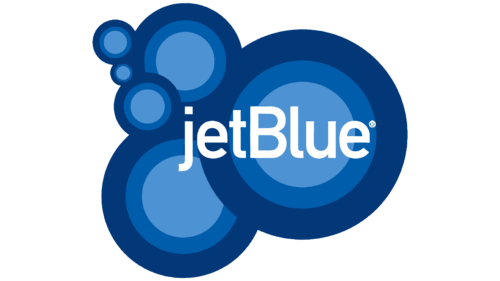JetBlue’s logo is textual, not reminding anything of its occupation. At the same time, it is austere, businesslike, and practical, positively affecting potential passengers because they see it as a reflection of protection and safety. The only link with professional activity is the blue color of the letters.
JetBlue: Brand overview
JetBlue is an American budget airline. It is the seventh largest on the North American continent and flies to many countries worldwide. The service is also among the top 10 in the number of passengers flown. It is headquartered in New York and has two out-of-town offices in Florida and Utah. This company has not one but two years of history. So, in 1998, it was first founded as NewAir, and in 2000, it began working under the current name. Its founder is a businessman, David Neeleman. He incorporated the firm in Delaware and opened an office in Forest Hills (Queens).
In August 1998, David Neeleman established NewAir, aiming to create what would eventually become JetBlue, a standout in American aviation.
By 1999, the company had secured $130 million in funding, marking a record for aviation startups in the United States.
On February 11, 2000, the airline’s inaugural commercial flight took off from New York’s JFK Airport, heading to Fort Lauderdale.
The air operator welcomed its first Airbus A320 in 2001, signaling a shift from the initial fleet of Boeing 737s.
The brand went public in 2002, listing its shares on the NASDAQ.
In 2004, the company introduced its loyalty program, TrueBlue, enhancing customer engagement.
The aviation firm launched coast-to-coast flights in 2005, linking the eastern and western seaboard of the U.S.
Following an operational crisis caused by an ice storm in February 2007, the airline underwent significant restructuring.
The brand forged international partnerships in 2008, notably with Lufthansa, to broaden its network.
The company moved to a new headquarters in Long Island City, New York, in 2009.
In 2013, the airline rolled out Mint, a premium service class for transcontinental travelers.
The aviation firm’s fleet saw the addition of the Airbus A321 in 2014.
After diplomatic relations were restored, the air operator made history in 2016 as the first U.S. airline to resume regular flights to Cuba.
The airline expanded its footprint significantly in the Caribbean and Latin America throughout 2017.
The aviation company revamped its loyalty program, TrueBlue, in 2018, offering enhanced benefits.
2019, the brand announced plans to begin transatlantic flights to London by 2021.
Amid changing market dynamics in 2020, the airline refocused on domestic routes and the Caribbean, adjusting its operations to meet new demands.
Meaning and History
After the renaming, the owners wanted to call the airline company Taxi, as it is directly related to the delivery of passengers. In this regard, they even chose a yellow livery for the planes in their fleet. In their opinion, this concept should have caused customers to associate it with New York, where the headquarters are located. However, after threats from the investor, the scandalous idea was scrapped. Otherwise, the aviation company would have lost 40 million dollars provided by JP Morgan. The result was JetBlue with one logo.
After the rebranding, it was time to change the logo design to match the name. The developers opted for a text logo with no graphic elements reminiscent of planes, altitude, and air travel. The meaning of such a concept is simple: no risk, delivery to the place, as if on the ground. The only nuance related to the sky was the color of the name.
With its minimalist logo, JetBlue wanted to convey that it is a low-cost carrier and focuses only on its core mission of delivering passengers. Despite the lack of flight-related graphics or imagery, the logo is a direct message about its line of business. That is why the management opted for textual symbolism.
What is JetBlue?
This is an American low-cost airline based in New York that revolutionized the air travel industry by offering high-quality service at affordable prices. The company serves an extensive network of destinations covering the United States, the Caribbean, Central America, and select cities in South America. The carrier operates a modern and efficient fleet, primarily consisting of Airbus A320 and Airbus A321 aircraft, equipped with comfortable leather seats, extra legroom, and a free in-flight satellite TV entertainment system.
2000 – today
By creating this logo, JetBlue aimed to solidify its market position as an affordable yet high-quality airline. The logo’s simple and clear design reflected the company’s philosophy of providing top-notch services while maintaining reasonable prices.
The emblem’s main feature is a horizontal inscription arranged in a single line. The logo consists of two connected parts. The first part, “jet,” is written in lowercase letters, directly pointing to the theme of flight and aviation. The second part, “Blue,” starts with a capital letter, visually separating the two semantic bases.
The logo’s font is sans-serif, modern, and clear. Using lowercase letters in “jet” creates a sense of simplicity and accessibility. In contrast, the capital letter in “Blue” adds an element of distinction and emphasizes the importance of this word. This combination of fonts underscores the balance between the company’s professionalism and friendliness.
The use of dark blue color and clear fonts highlighted the company’s commitment to professionalism and reliability. Blue is also associated with the sky, making it a perfect fit for an airline. It emphasizes the aviation theme and creates a sense of calm and safety.
Font and Colors
JetBlue’s visual identity is based on the commercial font FF Din Medium. This grotesque typeface was created by Albert-Jan Pool and first published by FontFont. The corporate palette uses the iconic dark shade of blue.







